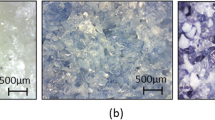Abstract
Knowing the grain geometry in grinding wheels is an asset for better understanding the grinding processes. This study investigates the grain protrusion and rake angles of two self-dressing zirconia-alumina grinding wheels in a robotic grinding process. The topography of the wheel is measured using a confocal scanning laser microscope. An optical image of the surface is used to create a mask of the grains with image processing techniques. Grain geometry information is then obtained by applying the mask to the entire surface. A vertex normal technique is used to find the cutting edges facing the cutting direction and only consider those edges in grain rake angle calculations. Surface parameters, including grain density, width, protrusion height, and rake angle, are extracted from the topography. The grinding wheel is characterized in low, medium, and high depths of cut in the range of robot operation. Results indicate that grain density, width, and protrusion height distribution are not affected by the depth of cut. It is also found that in shallow grinding, grain rake angle shifts slightly to higher negative angles; whereas, with a higher depth of cut, sharper edges exist on the wheel surface, which improve process efficiency.
Similar content being viewed by others

References
Doman DA, Bauer R, Warkentin A (2009) Experimentally validated finite element model of the rubbing and ploughing phases in scratch tests. Proceedings of the Institution of Mechanical Engineers, Part B (Journal of Engineering Manufacture), 223 (Copyright 2010, The Institution of Engineering and Technology): p. 1519–27
Liu Y et al (2013) Investigation of different grain shapes and dressing to predict surface roughness in grinding using kinematic simulations. Precis Eng 37(3):758–764
Aurich JC, Kirsch B (2012) Kinematic simulation of high-performance grinding for analysis of chip parameters of single grains. CIRP J Manuf Sci Technol 5(3):164–174
Verkerk J (1997) Final report concerning CIRP cooperative work on the characterization of grinding wheel topography. Lab. for Prod. Technol
Lonardo PM, Trumpold H, De Chiffre L (1996) Progress in 3D surface microtopography characterization. CIRP Ann Manuf Technol 45(2):589–598
Blunt L, Ebdon S (1996) The application of three-dimensional surface measurement techniques to characterizing grinding wheel topography. Int J Mach Tools Manuf 36(11):1207–1226
Butler DL et al (2002) The characterisation of grinding wheels using 3D surface measurement techniques. J Mater Process Technol 127(2):234–237
Nguyen AT, Butler DL (2008) Correlation of grinding wheel topography and grinding performance: a study from a viewpoint of three-dimensional surface characterisation. J Mater Process Technol 208(1–3):14–23
Xie J et al (2008) 3D graphical evaluation of micron-scale protrusion topography of diamond grinding wheel. Int J Mach Tools Manuf 48(11):1254–1260
Lachance S, Warkentin A, Bauer R (2003) Development of an automated system for measuring grinding wheel wear flats. J Manuf Syst 22(2):130–135
Inasaki I (1996) Grinding process simulation based on the wheel topography measurement. CIRP Ann Manuf Technol 45(1):347–350
Yan L et al (2011) Three-dimension surface characterization of grinding wheel using white light interferometer. Int J Adv Manuf Technol 55(1–4):133–141
Blunt L, Jiang X (2003) Advanced techniques for assessment surface topography: development of a basis for 3D surface texture standards "Surfstand". Elsevier Science
Weingaertner WL, Boaron A (2012) A method to determine the grinding wheel’s topography based on acoustic emission. Int J Abras Technol 5(1):17–32
Matsuno Y et al (1975) The microtopography of the grinding wheel surface with SEM. CIRP Ann Manuf Technol 43(1):237–242
Cui C et al (2013) Extraction of the grains topography from grinding wheels. Measurement 46(1):484–490
Xie J et al (2011) 3D laser investigation on micron-scale grain protrusion topography of truncated diamond grinding wheel for precision grinding performance. Int J Mach Tools Manuf 51(5):411–419
Darafon A, Warkentin A, Bauer R (2013) Characterization of grinding wheel topography using a white chromatic sensor. Int J Mach Tools Manuf 70:22–31
Malkin SGC (2008) Grinding technology: theory and applications of machining with abrasives, 2nd edn. Industrial Press, New York
Gonzalez R, Woods R (2007) Digital image processing (3rd Edition). Prentice Hall
Roberto Rodríguez M et al (2012) Image segmentation through an iterative algorithm of the mean shift
Comaniciu D, Meer P (2002) Mean shift: a robust approach toward feature space analysis. IEEE Trans Pattern Anal Mach Intell 24(5):603–619
Author information
Authors and Affiliations
Corresponding author
Rights and permissions
About this article
Cite this article
Tahvilian, A.M., Liu, Z., Champliaud, H. et al. Characterization of grinding wheel grain topography under different robotic grinding conditions using confocal microscope. Int J Adv Manuf Technol 80, 1159–1171 (2015). https://doi.org/10.1007/s00170-015-7109-z
Received:
Accepted:
Published:
Issue Date:
DOI: https://doi.org/10.1007/s00170-015-7109-z


